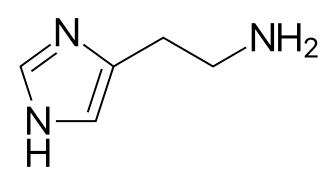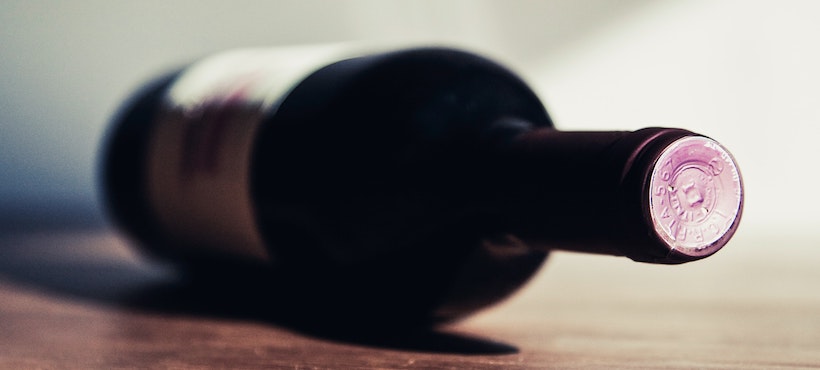There's nothing like matching a nice glass of red wine with a beautiful steak or a Pinot Grigio with a creamy pasta dish. It's the simple things in life; wine seems – at times – the perfect drink.
Alas, wine also sometimes seems like your worst enemy. Wine can cause some wicked headaches and stomachaches the following day, even after a mere one to two drinks.
There are many bogeymen in wine – such as tannins and sulfites – but save alcohol, histamines tend to cause the most problems.

Histamines play a central role in localized immune responses. They are organic compounds that your body releases from mast cells and basophils in response to stressors or foreign substances.
In the body, they have an essential role in affecting blood permeability and signaling the body to fight foreign invaders.
The side effects of histamines? You know them already – histamines are one of the substances that mediate allergies and allergic reactions. For starters, histamine release may result in a runny nose, a flushed face, frequent sneezing, and itching. Depending on where they're released, histamines can also trigger headaches and migraines or stomach aches, nausea, or diarrhea.

Histamines: a necessary yet potentially dangerous compound (Wikimedia)
Histamines were first isolated in 1910 by Sir Henry Dale, as he and his colleagues studied mold. After isolating histamines, their pioneering work explored the biological elements of the histamine reaction. They discovered a stimulant effect on smooth muscle from the gut and respiratory tract, lowered blood pressure, and could even induce a shock-like state in animals.
A few years later, in 1927, Best et al. discovered that histamine is a component of the human body. They found that histamine levels changed in the lungs after an anaphylactic reaction.
While scientists at the time argued whether the body was releasing histamine or merely breaking down the amino acid histidine, the race was on. Subsequent research concentrated on understanding histamine reactions – and searching for antihistamine drugs.
Histamine release is a natural reaction of the body to a foreign or irritating substance. It causes the human body to react and attempt to expel an invader or salve another stressor.
Histamine has a close association with an allergic reaction, whether to food, pollen, or some other substance your body sees as a threat. And since histamines aren't limited to humans, you can also get them in other ways... like through your food and drink.
Histamines studies, conducted in the 1950s showed that two different pathways in the body are activated by histamine. Further, there are four histamine receptor types – H1 - H4 – that histamine affects.
While your body can generally break down low levels of histamine you eat or drink, it's not a perfect process. If you consume food that's high in histamines, it's possible to affect the same receptors that you would with natural histamine. And a lot of those high-histamine foods are fun ones:

Wine, in particular, red wine, is full of histamines.
That's a general statement but not an absolute. A wine's histamine content depends on many things: the type of grape and the environment to how the wine is fermented and stored.
Let's switch to generalities for a second, and talk about how red and white wine compare on the histamine front.
Red wine, in general, has the most histamine content. (Of course, though, the levels vary between brands, types, and fermentation process.)
Histamine levels vary wildly between different reds, but in general, red wine contains 60 to 3,800 micrograms/liter of histamine. For reference, Switzerland used to set a max concentration of 10 mg/liter (or 10,000 micrograms a liter) to attempt to avoid severe histamine reactions.
This concentration is significantly higher than in white wine. As red wine is fermented, generally, you leave the stem, sticks, seeds, and skins while fermenting. This process leaves reds full of tannins but also causes more histamines in the finished product.
White wine has fewer histamines compared to red. The concentration generally clocks in at 3 to 120 micrograms/liter.
If you're histamine sensitive, that's a significant gap. Red wines usually have three times – or more – the histamine concentration versus white wines. That might be the difference between feeling terrible or shaking it off the day after a third glass.
Champagne acts more like white wine and splits the difference in histamine content with red and white. Typically, champagne contains a histamine concentration of 15-670 micrograms/liter.
Okay, it's not wine – but beer contains histamines too. The same study benchmarked beer between a histamine concentration of 21-305 micrograms a liter.

The actual reactions you have to histamines and wine comes down to your own body type, chemistry, and sensitivities. In fact, some people are actually allergic to the sulfites in wine, and their bodies would be producing natural histamines in reaction to their intake.
But to break it all down, the Wand Lab found up to 75% of wine drinkers will have some reaction to the histamines (or sulfites) in the wine.
They classified the major symptoms as:
Note that some folks experience these symptoms with a single glass of wine. You should always enjoy your wine in moderation, but yes – more glasses increase the risk of experiencing any histamine linked symptoms.
These aren't the only symptoms you may experience from the histamines in wine, however. Some people will have digestive symptoms, or brain fog, among other symptoms – it's hard to know exactly how histamine (and alcohol too!) will affect your system, so always take it easy.

Histamines are not the only bogeymen in wine. Especially with red wine, you will often hear people talk about tannins and sulfites. Let's talk a bit about tannins and sulfites and about how they affect your drinks.
Tannins are a polyphenol that occurs naturally in types of plants, wood, bark, leaves, and the skins of fruit. Grapes are (of course) a fruit – especially with red wines, much of wine's tannin content comes from the skins and stems of grapes which are left with the wine as it ferments. Tannins impart a bitter or dry taste to wine, which is desirable in many cases. You taste or feel tannins in the middle and front of your tongue.
White wine does not have as many tannins as red, but the type of barrel the winemaker uses can cause the wood to transfer the tannins into the wine. Oak imparts an interesting flavor (usually even called "oaky") because the tannins from an oak barrel will make their way into the wine.
Sulfites are present in all types of wine – both naturally and added by winemakers as a preservative. Winemakers use them to help reduce the amount of oxidation that takes place in wine and to help the wine remain fresh during the fermenting and storage process. They also control the bacteria in the wine to prevent the wine from spoiling.
Histamines are by far the biggest trigger for wine drinking symptoms. However, some people are allergic or sensitive to sulfites or tannins instead (well, or too) – only an allergist can help you figure out which one is triggering if you have issues.

Histamines, as noted above, do not affect everyone the same. Depending on your own constitution, you may break down the vast majority before they can cause issues and never experience any symptoms.
For others, they are very intolerant of external histamines. These folks might have a couple of sips of wine and almost instantly get a headache.
Histamine intolerance is an allergic response to the high levels of histamine in the wine. Not everyone experiences the same symptoms, but here's what you might experience if you're intolerant:
The most severe reactions (extreme sensitivity) can include the following symptoms,
That's a load of symptoms for the type of wine that, ostensibly, is the healthier option. Let's talk a little bit more about how you break down histamines in your body.

Diamine oxidase (DAO) is an enzyme that allows us to break down histamines in our bodies. Sufficient DAO deactivates or nullifies the effects of histamine in your food or drink.
As I've noted, some people have more DAO than others. It's also something you can purchase as a supplement, and consume at the same time as your wine or other histamine-heavy mean. Outside of supplements, DAO is also in some foods – including foods that otherwise have high amounts of histamine.
Histamines are not dangerous per se, but they can become dangerous in high enough quantities. That can mean either ingesting too many in food or drink, or in an allergic reaction – or even from anaphylaxis. The responses to histamine in your body can trigger other problems such as raised (or paradoxically, lowered) blood pressure, breathing issues, swelling of the throat or skin, rashes, and other issues.
Histamine in low doses is good for your body. It helps to protect it from infectious organisms and foreign stressors. It's only when histamines are present in overwhelming quantities that they are dangerous. Chronically elevated histamine levels can even cause disease – too many histamines commonly present can cause new allergies to food, drink, or other things (like bee stings or latex), or even mast cell disease.
Tyramine is a component of red wine and another amine, like histamine. Specifically, it is generated in the breakdown of the amino acid tyrosine.
It is released as a chemical in your brain to act on your neurotransmitters and your hormones. It provides your body with energy, but it also raises your blood pressure and heart rate.
Tyramine is also part of the fight or flight response in the body, and you'll find it often accompanies histamines. In small amounts, it can save your life in a low-blood pressure crisis – but it can turn deadly if you have too much in your blood.

Regardless of your type of drink, hangovers are common. Unfortunately, we don't know the exact trigger, but it does seem that depending on the drink and its components, hangovers will differ in type and duration. One hangover might be vomiting, headaches, and brain fog all day, versus another which might only be light nausea.
Certainly, alcohol drives much of a hangover, but histamine's after-effects can play a role. Luckily, there are some things you can do to minimize the effects before – and after – drinking.
Getting enough sleep is crucial for overall good health, but lack of sleep can also affect how an alcoholic drink affects your system.
When your sleep is disturbed, fatigue, irritability, and headaches are standard (even without alcohol!), along with the other symptoms of a hangover. Poor sleep just makes a hangover all the more likely.
Staying hydrated is essential for the body and mind to remain alert and sharp. Drinking wine or any alcohol causes a diuretic effect; alcohol effectively dehydrates your body. While dehydration is only one thing that happens to your body when you drink alcohol, it can make it more likely for you to develop the symptoms of a hangover.
Increasing your intake of water can help reduce symptoms of a hangover or eliminate them, including fatigue, headache, and dizziness. If you are sensitive to the histamines in wine, staying well hydrated can significantly reduce your symptoms.
Drinking fruit or vegetable juice before or during wine consumption can reduce or eliminate the effects of a hangover. A small study conducted on 15 adults found that those that consumed a juice or vegetable drink mix suffered fewer symptoms of a hangover. In some cases, the signs of alcohol toxicity were even eliminated through their green grape juice and pear drink consumption.

Unfortunately, some of the best tasting foods to pair with wine are also the most dangerous if you are sensitive to the histamines in wine.
Here's a more extensive list of high-histamine foods:
Other foods should be monitored for levels of acidity or histamines as well as they can also cause reactions when mixed with wine consumption.
If you're extremely sensitive? You can try a low-histamine diet to try to find what foods are causing you issues. With such a plan, it's best to get started under the auspices of a dietician or RN to avoid undernourishment, but rotating histamine-laden foods is often helpful if you're histamine sensitive.
Most commonly, high histamine wines are a result of the way the wine is made, the type of barrel it is fermented in, and the kind of wine it is (read: what types of grapes the wine comes from).
Red wines fermented with grape seeds and in wooden barrels of various sorts will add more histamine to the wine. Luckily – if you're among the histamine sensitive – some wines have lower levels naturally or are fermented to be as low histamine as possible.
Wines made in Washington State, California, or Oregon have lower histamine levels than most anything made in Europe. The working theory is soil conditions in the Pacific Northwest and the West Coast of America have more amenable soil conditions for low-histamine levels. Further still, some histamine-aware winemakers use lower histamine-promoting barrels to try to finish with a histamine-reduced wine.

The concentration of tannins in the wine can also give some histamine level clues.
As I mentioned, tannins often get blamed for sensitivity to red wine, but they often are highly concentrated alongside histamines. Tannin gives the wine a very dry taste and feeling in your mouth, so if a wine tastes dry and you're histamine-sensitive, you might want to reconsider the glass in your hand.
While it is not impossible to find low-histamine red wines, you will have research growers' claims and see if they match your expectations with a low-histamine process.
Most people have at least a minor sensitivity to high histamine wines. That often doesn't mean you need to avoid histamine-laden wines altogether, but it does mean you need to watch your drinking more than usual.
If you find yourself among the histamine sensitive, you can try to eat low-histamine during the day, so your overall histamine levels aren't as affected by a glass of fine red.
Or – if it's an option – just stick to the whites and rosés.
Who is Gerard Paul?? Well-written fairly easy to read text, but NO academic sources identified?
Hey Donald, thanks for stopping by! Of course, I'm an enthusiast – okay, a winedrinker not a winemaker – all of the references are inline with the text. PubMed alone should have over 15 references.
Which browser or device are you on? I'd like to test those show up okay. I bumped the link color too to try to improve the contrast.
Thanks for the read and the kind words!
With 40 years experience of selling wine retail, I found your comments succinct, easy to read and something I will be able to pass on to customers who believe that it is all the fault of sulphur. Too many times have I heard misconceptions about peoples' inability to drink/handle certain types of wine and why and now I can refer them to your article. Thanks!
Thanks so much Ian, really glad you enjoyed it!
This post was inspired for the same reason – I have issues with reds sometimes, and heard too much "tannins" and "sulfites" talk.
If there's a problem with drinking reds, but not whites, it's not sulfites, since levels are almost always higher in whites. As you describe, point the finger at tannin/polyphenols, or more likely histamine. Well done.
Thanks for the nice comment, Bernard! I did go down the tannin rabbit-hole too – a heavy load can definitely cause headaches, nausea, indigestion and the like. And some folks are oversensitive to tannins (usually they get headaches). And as you know oak barrels can lend tannins to whites too... and folks generally have fewer problems.
My take is – I agree histamine is your first stop to identifying any issues, followed probably by tannins, sulfites third.
Thank you for this article, which helped me understand histamines in wine better.
Can you say more about the source of this statement (the link on the word Europe goes to a blank page)?:
'Wines made in Washington State, California, or Oregon have lower histamine levels than most anything made in Europe. The working theory is soil conditions in the Pacific Northwest and the West Coast of America have more amenable soil conditions for low-histamine levels.'
Very strange WSJ dropped the link – I found it at a new URL and updated. Cheers!